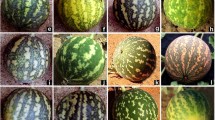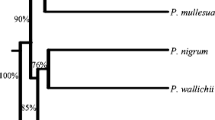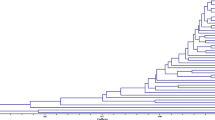Summary
Random amplified polymorphic DNA (RAPD) analysis was carried out to evaluate polymorphism and genetic similarity between 39 Mediterranean mandarin genotypes. One hundred eleven amplification products were identified using 21 random primers. An average of 2.2 RAPD markers was obtained for each primer, corresponding to 42% of the amplification products. Genotype-specific RAPD markers were also found, mainly in known hybrids. UPGMA cluster analysis revealed the low level of genetic variation between accessions of Mediterranean mandarins, whereas their hybrids with other Citrus species showed greater genetic dissimilarity. Twenty accessions yielded very similar patterns, suggesting either that they could be a single clone, or that the technique was not able to detect genomic variation. However, for the other specimens genetic polymorphism can easily be detected by RAPD, although the genetic variation between accessions was quite low. The large number of hybrids and the low polymorphism between accessions support the hypothesis that Mediterranean mandarins are all true hybrid of Common mandarins (Citrus reticulata Blanco).
Similar content being viewed by others
References
Ashari, S., D., Aspinall & M., Sedgley, 1989. Identification and investigation of relationships of mandarin types using isozyme analysis. Sci Hort 40: 305–315.
Caetano-Anollés, G., B.J., Bassam & P.M., Gresshoff, 1991. DNA amplification fingerprint using very short arbitrary oligonucleotide primers. Biotechnology 9: 553–556.
Chapot, H., 1962. La mandarine commune. Al Awamia 5: 29–51.
Grattapaglia, D., D. O'Malley & R. Sederoff, 1992. Multiple applications of RAPD markers to genetic analysis in Eucalyptus sp. In: Proc. IUFRO Conf. ‘Breeding Tropical Trees’, pp. 2–8. Section 2.
Grattapaglia, D. & R., Sederoff, 1994. Genetic linkage maps of Eucalyptus grandis and Eucalyptus urophylla using a pseudotestcross. Mapping strategy and RAPD markers. Genetics 137: 1121–1137.
Handa, T., Y., Ishizawa & C., Oogaki, 1986. Phylogenetic study of fraction I protein in the genus Citrus and its close related genera. Jpn J Genet 61: 15–24.
Hodgson, R.W., 1967. Horticultural varieties of Citrus. In: W., Ruether, H.J., Webber & L.D., Batchelor (Eds.), The Citrus Industry, pp. 431–586. University of California, USA.
Luro, F., F. Laigret & J.M. Bove, 1992. Application of random amplified polymorphic DNA (RAPD) to Citrus genetics and taxonomy. Proc Int Soc Citriculture 225–228.
Motohashi, R., T. Matsuyama & T. Akihama, 1992. DNA finger-printing in Citrus cultivars. Proc Int Soc Citriculture 121–224.
Murray, M.G.,& W.F., Thompson, 1980. Rapid isolation of high molecular weight plant DNA. Nucl Acids Res 8: 4321–4325.
Paran, I., R., Kesseli & R., Michelmore, 1991. Identification of RFLP and RAPD markers linked to downy mildew resistance genes in lettuce using near-isogenic lines. Genome 34: 1021–1027.
Rohlf, F.J., 1992. NTSYS-pc Numerical taxonomy and multivariate analysis system (version 1.7). State University of New York.
Roose, M.L., 1988. Isozymes and DNA restriction fragment length polymorphisms in citrus breeding and systematics. Proc Int Soc Citriculture: 155–165.
Sambrook, J., E.F., Fritsch & T., Maniatis, 1989. Molecular cloning: A laboratory manual. Cold Spring Harbor Laboratory, Cold Spring Harbor, New York.
Swingle, W.T., 1943. The botany of citrus and its wild relatives of the orange subfamily. In: H.J., Webber & L.D., Batchelor (Eds.), The Citrus Industry, pp. 129–472. 1st ed., Berkeley: Univ Calif, Vol 1.
Tanaka, T., 1954. Species problems in citrus. Japanese Society Promotion of Science, Tokyo, 152 p.
Webber, H.J., 1943. Cultivated varieties of Citrus. In: H.J., Webber & L.D., Batchelor (Eds.), The Citrus Industry, pp. 475–642. 1st ed., Berkeley, Univ Calif, Vol 1.
Wilde, J., R., Waugh & W., Powell, 1992. Genetic fingerprinting of Theobrama clones using randomly amplified polymorphic DNA markers. Theor Appl Genet 83: 871–877.
Author information
Authors and Affiliations
Rights and permissions
About this article
Cite this article
Machado, M.A., Coletta Filho, H.D., Targon, M.L.P.N. et al. Genetic relationship of Mediterranean mandarins (Citrus deliciosa Tenore) using RAPD markers. Euphytica 92, 321–326 (1995). https://doi.org/10.1007/BF00037115
Received:
Accepted:
Issue Date:
DOI: https://doi.org/10.1007/BF00037115




